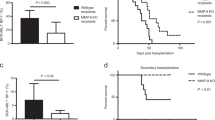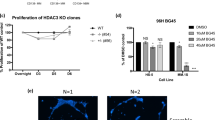Abstract
B cell malignancies frequently colonize the bone marrow. The mechanisms responsible for this preferential homing are incompletely understood. Here we studied multiple myeloma (MM) as a model of a terminally differentiated B cell malignancy that selectively colonizes the bone marrow. We found that extracellular CyPA (eCyPA), secreted by bone marrow endothelial cells (BMECs), promoted the colonization and proliferation of MM cells in an in vivo scaffold system via binding to its receptor, CD147, on MM cells. The expression and secretion of eCyPA by BMECs was enhanced by BCL9, a Wnt–β-catenin transcriptional coactivator that is selectively expressed by these cells. eCyPA levels were higher in bone marrow serum than in peripheral blood in individuals with MM, and eCyPA-CD147 blockade suppressed MM colonization and tumor growth in the in vivo scaffold system. eCyPA also promoted the migration of chronic lymphocytic leukemia and lymphoplasmacytic lymphoma cells, two other B cell malignancies that colonize the bone marrow and express CD147. These findings suggest that eCyPA-CD147 signaling promotes the bone marrow homing of B cell malignancies and offer a compelling rationale for exploring this axis as a therapeutic target for these malignancies.
This is a preview of subscription content, access via your institution
Access options
Subscribe to this journal
Receive 12 print issues and online access
$209.00 per year
only $17.42 per issue
Buy this article
- Purchase on Springer Link
- Instant access to full article PDF
Prices may be subject to local taxes which are calculated during checkout






Similar content being viewed by others
Accession codes
Change history
25 January 2024
A Correction to this paper has been published: https://doi.org/10.1038/s41591-024-02820-2
References
Talmadge, J.E. & Fidler, I.J. AACR centennial series: the biology of cancer metastasis: historical perspective. Cancer Res. 70, 5649–5669 (2010).
Valastyan, S. & Weinberg, R.A. Tumor metastasis: molecular insights and evolving paradigms. Cell 147, 275–292 (2011).
Kuehl, W.M. & Bergsagel, P.L. Molecular pathogenesis of multiple myeloma and its premalignant precursor. J. Clin. Invest. 122, 3456–3463 (2012).
Muller-Hermelink, H.K. et al. Chronic lymphocytic leukemia/small lymphocytic lymphoma. World Health Organization Classification of Tumours of Haematopoietic and Lymphoid Tissues 4th edn. (eds. Swerdlow, S.H. et al.) 180–182 (IARC Press, 2008).
Anderson, K.C. Oncogenomics to target myeloma in the bone marrow microenvironment. Clin. Cancer Res. 17, 1225–1233 (2011).
Vande Broek, I., Vanderkerken, K., Van Camp, B. & Van Riet, I. Extravasation and homing mechanisms in multiple myeloma. Clin. Exp. Metastasis 25, 325–334 (2008).
Ghobrial, I.M. Myeloma as a model for the process of metastasis: implications for therapy. Blood 120, 20–30 (2012).
Jakob, C. et al. Angiogenesis in multiple myeloma. Eur. J. Cancer 42, 1581–1590 (2006).
Ribatti, D. & Vacca, A. The role of microenvironment in tumor angiogenesis. Genes Nutr. 3, 29–34 (2008).
Ribatti, D., Nico, B. & Vacca, A. Importance of the bone marrow microenvironment in inducing the angiogenic response in multiple myeloma. Oncogene 25, 4257–4266 (2006).
Ria, R. et al. Gene expression profiling of bone marrow endothelial cells in patients with multiple myeloma. Clin. Cancer Res. 15, 5369–5378 (2009).
Alsayed, Y. et al. Mechanisms of regulation of CXCR4/SDF-1 (CXCL12)-dependent migration and homing in multiple myeloma. Blood 109, 2708–2717 (2007).
Mani, M. et al. BCL9 promotes tumor progression by conferring enhanced proliferative, metastatic, and angiogenic properties to cancer cells. Cancer Res. 69, 7577–7586 (2009).
Polakis, P. Drugging Wnt signalling in cancer. EMBO J. 31, 2737–2746 (2012).
Clevers, H. & Nusse, R. Wnt/β-catenin signaling and disease. Cell 149, 1192–1205 (2012).
de la Roche, M. et al. An intrinsically labile α-helix abutting the BCL9-binding site of β-catenin is required for its inhibition by carnosic acid. Nat. Commun. 3, 680 (2012).
Takada, K. et al. Targeted disruption of the BCL9/β-catenin complex inhibits oncogenic Wnt signaling. Sci. Transl. Med. 4, 148ra117 (2012).
Giuliani, N., Colla, S. & Rizzoli, V. Angiogenic switch in multiple myeloma. Hematology 9, 377–381 (2004).
Rood, P.M., Calafat, J., von dem Borne, A.E., Gerritsen, W.R. & van der Schoot, C.E. Immortalisation of human bone marrow endothelial cells: characterisation of new cell lines. Eur. J. Clin. Invest. 30, 618–629 (2000).
Mitsiades, C.S., Mitsiades, N.S., Munshi, N.C., Richardson, P.G. & Anderson, K.C. The role of the bone microenvironment in the pathophysiology and therapeutic management of multiple myeloma: interplay of growth factors, their receptors and stromal interactions. Eur. J. Cancer 42, 1564–1573 (2006).
De Bruyne, E. et al. Myeloma cells and their interactions with the bone marrow endothelial cells. Curr. Immunol. Rev. 3, 41–55 (2007).
Hideshima, T. & Anderson, K.C. Molecular mechanisms of novel therapeutic approaches for multiple myeloma. Nat. Rev. Cancer 2, 927–937 (2002).
Chen, H. et al. Extracellular signal-regulated kinase signaling pathway regulates breast cancer cell migration by maintaining slug expression. Cancer Res. 69, 9228–9235 (2009).
Calimeri, T. et al. A unique three-dimensional SCID-polymeric scaffold (SCID-synth-hu) model for in vivo expansion of human primary multiple myeloma cells. Leukemia 25, 707–711 (2011).
Song, F. et al. Cyclophilin A (CyPA) induces chemotaxis independent of its peptidylprolyl cis-trans isomerase activity: direct binding between CyPA and the ectodomain of CD147. J. Biol. Chem. 286, 8197–8203 (2011).
Nigro, P., Pompilio, G. & Capogrossi, M.C. Cyclophilin A: a key player for human disease. Cell Death Dis. 4, e888 (2013).
Yurchenko, V., Constant, S., Eisenmesser, E. & Bukrinsky, M. Cyclophilin-CD147 interactions: a new target for anti-inflammatory therapeutics. Clin. Exp. Immunol. 160, 305–317 (2010).
Weidle, U.H., Scheuer, W., Eggle, D., Klostermann, S. & Stockinger, H. Cancer-related issues of CD147. Cancer Genomics Proteomics 7, 157–169 (2010).
Damsker, J.M. et al. Targeting the chemotactic function of CD147 reduces collagen-induced arthritis. Immunology 126, 55–62 (2009).
Sanderson, R.D. & Borset, M. Syndecan-1 in B lymphoid malignancies. Ann. Hematol. 81, 125–135 (2002).
Comerford, I., Kara, E.E., McKenzie, D.R. & McColl, S.R. Advances in understanding the pathogenesis of autoimmune disorders: focus on chemokines and lymphocyte trafficking. Br. J. Haematol. 164, 329–341 (2014).
Agrawal, S.M. & Yong, V.W. The many faces of EMMPRIN—roles in neuroinflammation. Biochim. Biophys. Acta 1812, 213–219 (2011).
Arendt, B.K. et al. Increased expression of extracellular matrix metalloproteinase inducer (CD147) in multiple myeloma: role in regulation of myeloma cell proliferation. Leukemia 26, 2286–2296 (2012).
Iacono, K.T., Brown, A.L., Greene, M.I. & Saouaf, S.J. CD147 immunoglobulin superfamily receptor function and role in pathology. Exp. Mol. Pathol. 83, 283–295 (2007).
Suzuki, J., Jin, Z.G., Meoli, D.F., Matoba, T. & Berk, B.C. Cyclophilin A is secreted by a vesicular pathway in vascular smooth muscle cells. Circ. Res. 98, 811–817 (2006).
Niu, H., Wang, R., Cheng, J., Gao, S. & Liu, B. Treatment of (131)I-labeled anti-CD147 monoclonal antibody in VX2 carcinoma-induced liver tumors. Oncol. Rep. 30, 246–252 (2013).
McMillin, D.W. et al. Tumor cell-specific bioluminescence platform to identify stroma-induced changes to anticancer drug activity. Nat. Med. 16, 483–489 (2010).
Sukhdeo, K. et al. Targeting the β-catenin/TCF transcriptional complex in the treatment of multiple myeloma. Proc. Natl. Acad. Sci. USA 104, 7516–7521 (2007).
Lanemo Myhrinder, A. et al. Molecular characterization of neoplastic and normal “sister” lymphoblastoid B-cell lines from chronic lymphocytic leukemia. Leuk. Lymphoma 54, 1769–1779 (2013).
Ditzel Santos, D. et al. Establishment of BCWM.1 cell line for Waldenstrom's macroglobulinemia with productive in vivo engraftment in SCID-hu mice. Exp. Hematol. 35, 1366–1375 (2007).
Zhao, J.J. et al. miR-30-5p functions as a tumor suppressor and novel therapeutic tool by targeting the oncogenic Wnt/β-catenin/BCL9 pathway. Cancer Res. 74, 1801–1813 (2014).
Chng, W.J. et al. Molecular dissection of hyperdiploid multiple myeloma by gene expression profiling. Cancer Res. 67, 2982–2989 (2007).
Peng, J. & Gygi, S.P. Proteomics: the move to mixtures. J. Mass Spectrom. 36, 1083–1091 (2001).
Levanon, K. et al. Primary ex vivo cultures of human fallopian tube epithelium as a model for serous ovarian carcinogenesis. Oncogene 29, 1103–1113 (2010).
Ficarro, S.B. et al. Improved electrospray ionization efficiency compensates for diminished chromatographic resolution and enables proteomics analysis of tyrosine signaling in embryonic stem cells. Anal. Chem. 81, 3440–3447 (2009).
Acknowledgements
R.D.C. is supported by a senior award from the Multiple Myeloma Research Foundation, by the Doctors Cancer Foundation, and by grants 1R01 CA151391-01 and 1P01 CA155258-01 from the National Institutes of Health. Human bone marrow–derived endothelial cell lines BMEC-60 and BMEC-1 were kindly provided by Dr. van der Schoot (University of Amsterdam, Amsterdam, the Netherlands) and Dr. Giuliani (University of Parma, Parma, Italy), respectively.
Author information
Authors and Affiliations
Contributions
D.Z. performed most of the experiments, analyzed the data and prepared the manuscript; Z.W. performed ELISA studies and helped with immunoblots; J.M. planned and coordinated proteomic experiments; J.-J.Z. generated reagents; C.S.M. helped with scaffold experiments; S.B.F. performed total proteomic analysis; D.M. and C.S.M. helped with the design of cell-specific bioluminescence imaging experiments for myeloma–endothelial cell cocultures; D.M.D. selected subjects and analyzed CD147 expression by flow cytometry; T.H. performed the complement-dependent cytotoxicity assay; H.T. performed animal imaging; Y.K. performed proteomic analysis; G.P. performed immunohistochemistry studies; Y.-T.T., C.J.W., S.P.T., Z.H., M.F. and N.C.M. provided clinical samples and critically reviewed the manuscript; K.C.A. provided clinical samples and edited the manuscript; J.A.M. supervised the proteomic studies; P.T. and T.C. provided scaffolds, as well as technical and scientific assistance with scaffold experiments; and R.D.C. designed experiments, analyzed data and wrote the manuscript.
Corresponding author
Ethics declarations
Competing interests
The authors declare no competing financial interests.
Supplementary information
Supplementary Text and Figures
Supplementary Figures 1–10 and Supplementary Tables 1–2 (PDF 2138 kb)
Rights and permissions
About this article
Cite this article
Zhu, D., Wang, Z., Zhao, JJ. et al. The Cyclophilin A–CD147 complex promotes the proliferation and homing of multiple myeloma cells. Nat Med 21, 572–580 (2015). https://doi.org/10.1038/nm.3867
Received:
Accepted:
Published:
Issue Date:
DOI: https://doi.org/10.1038/nm.3867
This article is cited by
-
Prognostic Significance of Tumor-Associated Inflammation in Renal Cell Carcinoma
Bulletin of Experimental Biology and Medicine (2024)
-
siRNA Lipid–Polymer Nanoparticles Targeting E-Selectin and Cyclophilin A in Bone Marrow for Combination Multiple Myeloma Therapy
Cellular and Molecular Bioengineering (2023)
-
Exploiting DNA Ligase III addiction of multiple myeloma by flavonoid Rhamnetin
Journal of Translational Medicine (2022)
-
Hypo-phosphorylated CD147 promotes migration and invasion of hepatocellular carcinoma cells and predicts a poor prognosis
Cellular Oncology (2019)
-
Cyclophilin J limits inflammation through the blockage of ubiquitin chain sensing
Nature Communications (2018)



